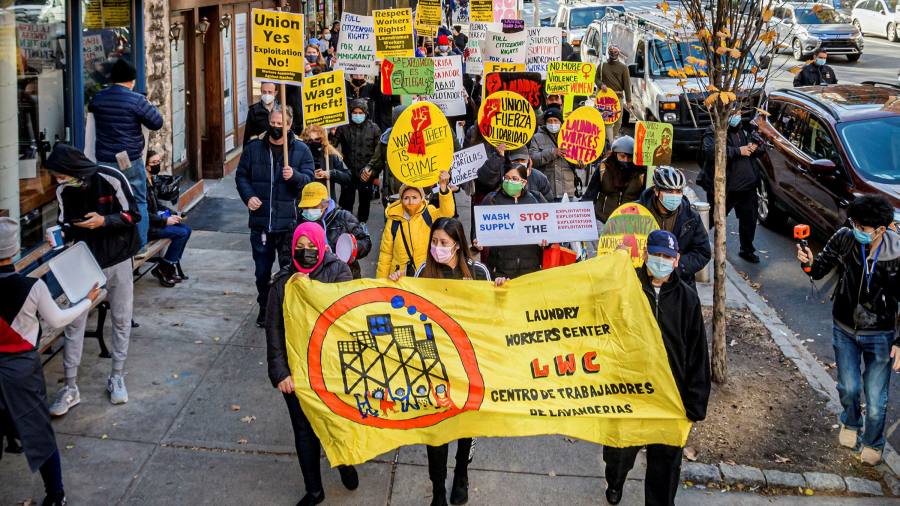[ad_1]
If you were in any doubt about US President Joe Biden’s determination to change the balance of power between capital and labour in the world’s biggest economy, consider the fate of a man called Peter Robb.
Minutes after Mr Biden took office on January 20, he asked Mr Robb to resign as general counsel of the National Labor Relations Board, the federal agency that protects workers’ rights to organise. Unions had complained that Mr Robb, a former management-side lawyer appointed by Donald Trump, was eroding worker rights and hollowing out the agency. When he refused to resign, Mr Biden fired him and later his deputy.
Consider, too, the Office of Information and Regulatory Affairs, a small but powerful agency that reviews major regulatory proposals before they take effect. Progressives such as Elizabeth Warren have long complained that OIRA slows down or weakens new rules and is susceptible to corporate lobbying. Mr Biden has installed Sharon Block at the agency. She supports reform to turn it into “a force for making sure that the most progressive regulations get through the gateâ€, she wrote in April last year.
Chicken factories provide a third signal. Mr Biden blocked Trump administration plans to allow chicken factories to speed up production lines, which safety experts had warned would exhaust workers and make them more vulnerable to Covid-19.
Amid eye-catching policy proposals such as a $15 minimum wage, it’s easy to miss these small changes deep in the belly of US bureaucracy. But they reveal the breadth of Mr Biden’s ambition and the attention to detail that underpins it.
That doesn’t mean it will be easy. In 2020, only 6.3 per cent of private sector workers in the US were members of a union. In key sectors for working-class jobs such as personal care, food service and retail, the figure is less than 5 per cent. But Heidi Shierholz, director of policy at the Economic Policy Institute, says Mr Biden’s approach so far to workers’ rights is very different from previous Democratic presidents Bill Clinton and Barack Obama.
“We’re in the very beginning of this but the early signs are that the Biden administration is really centring worker power, collective bargaining, social justice, in a way that’s different to what we’ve seen in the past,†she says.
The UK provides a striking counterpoint. Here, too, political leaders have promised to improve working conditions at the bottom of the labour market. When Theresa May became prime minister in 2016, she told working-class families: “I know you’re doing your best, and I know that sometimes life can be a struggle. The government I lead will be driven not by the interests of the privileged few, but by yours.†She commissioned a review of workers’ rights and promised to act on its recommendations.
The pandemic has underlined the urgency. Rising unemployment, which makes workers more desperate for jobs, is likely to exacerbate the UK’s problem with poor enforcement of the minimum wage. Meanwhile, the virus has ripped through workplaces with poor working conditions such as meat plants and garment factories. Boris Johnson, Mrs May’s successor, has promised to “build back better†and address longstanding problems that were “brutally illuminated in that Covid lightning flashâ€.
Yet the post of director of labour market enforcement has just fallen vacant. The government advertised the job in November but has failed to appoint anyone, and declined an offer from the incumbent, Matthew Taylor, to carry on unpaid in the meantime. It has also failed to publish his latest strategy, which was completed in March last year. An employment bill has been promised but is yet to appear. Important policy questions raised by shifts in the nature of work, such as how to protect workers in the gig economy, remain unaddressed.
Unions fear the UK government plans to use Brexit to dismantle workers’ rights in a bid to boost “competitiveness†and liberate employers from “red tapeâ€. These fears seemed well-grounded last month when it became clear the business department was reviewing the rights enshrined in the European Working Time Directive, such as holiday pay and rest breaks.
Ministers U-turned on this idea after the public objected and businesses pointed out they didn’t particularly want to be “liberatedâ€. It seems less likely the government has a secret plan to weaken workers’ rights than that it has no clear strategy at all.
The past two weeks have shown that Mr Biden is trying to steer a new course for the US economy. The UK, in contrast, is flapping in the wind.
[ad_2]
Source link






